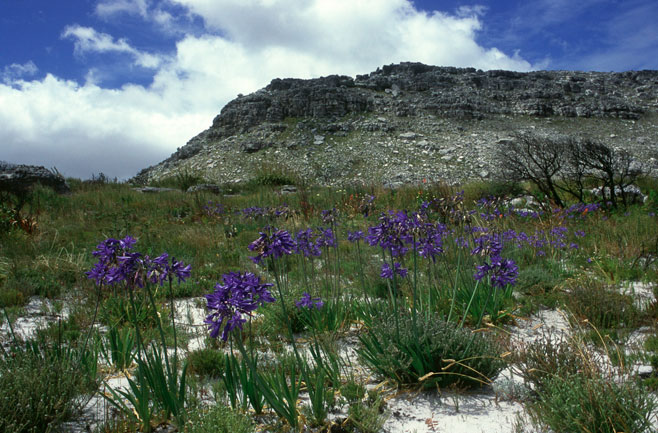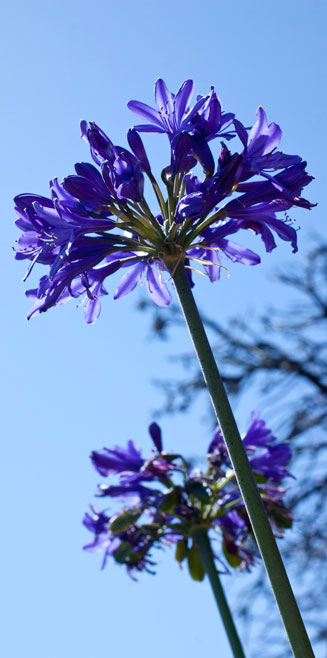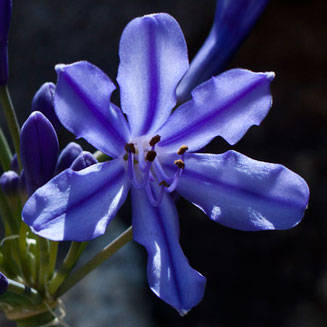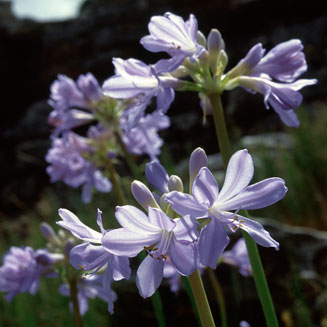Agapanthus africanus (Cape agapanthus)
Life
> eukaryotes >
Archaeoplastida >
Chloroplastida
>
Charophyta > Streptophytina > Plantae (land plants)
> Tracheophyta (vascular plants) > Euphyllophyta > Lignophyta (woody plants)
> Spermatophyta (seed plants) > Angiospermae (flowering
plants)
> Monocotyledons > Order: Asparagales
> Family: Amaryllidaceae > Genus: Agapanthus
 |
|
Agapanthus africanus flowering in summer, a
year after a burn on the Cape Peninsula mountains, South Africa. [photo
Colin Paterson-Jones ©] |
 |
 |
 |
|
Left: a dark-flowered form of Agapanthus africanus
flowering in summer on the Cape Peninsula mountains, South Africa.
[photo
Colin Paterson-Jones ©] Top right: Agapanthus africanus flowering
in summer after a burn in the Kogelberg Biosphere Reserve, Western
Cape, South Africa. [photo
Colin Paterson-Jones ©]
Bottom right: a pale form of Agapanthus africanus
flowering in summer on the Cape Peninsula mountains, South Africa.
[photo Colin Paterson-Jones ©] |
Distribution and habitat
Occurs in fynbos on rocky, sandy slopes, from
Cape Peninsula to Swellendam in the Western Cape, South Africa
(Manning et al. 2002, Goldblatt and Manning 2000).
Subspecies
- Agapanthus africanus ssp. africanus. Flowers
and flower stalks (pedicels) erect. This is the main subspecies
found from Cape Town to Swellendam.
- Agapanthus africanus ssp. walshii. Flowers and
flower stalks drooping, an adaptation for bird pollination.
Until recently this was regarded as a full species but the paper
by Zonneveld and Duncan (2003) has recommended otherwise. This
subspecies is found on rocky sandstone parts of the Steenbras
mountains and flowers profusely only after fire (Bean and Johns
2005).
Life cycle
- Flowers from December to April, mainly after fire (Manning
et al. 2002, Goldblatt and Manning 2000).
- Flowers of subspecies africanus are visited by large
bees, particularly carpenter bees (Xylocopa) whereas
those of subspecies walshii are visited by sunbirds
(Manning et al. 2002).
- The fruit is a three-angled capsule containing flat, black
winged seeds (Manning et al. 2002). As they grow on windy
slopes, the fruiting head is fairly high above ground level (up
to 70 cm) and they have winged seeds, presumably seed dispersal
is mainly by wind?
- Leaves are retained throughout the year (evergreen) whereas
summer-rainfall Agapanthus species tend to have deciduous
leaves (Leighton 1965).
Chemistry
See under
Agapanthus. Many
references to Agapanthus africanus in the past were referring
to the species in the broad sense, which included what are now
considered a number of separate species. For this reason it has been
considered best to review Chemistry and Uses for the genus as a
whole.
Uses
As for Chemistry, see under
Agapanthus.
Links
Publications
-
Bean, A. and Johns, A. 2005. Stellenbosch to Hermanus. South African Wild
Flower Guide 5. Second Revised Edition. Botanical Society of South
Africa, Cape Town.
-
Goldblatt P. and Manning J. 2000. Cape Plants - A Conspectus of the Cape
Flora of South Africa. National Botanical Institute, Pretoria and
Missouri Botanical Garden Press, Missouri.
-
Leighton F.M. 1965. The genus Agapanthus
L'Hérit. Journal of South African Botany Suppl. 4: 1-50.
-
Manning J., Goldblatt P. and Snijman D. 2002. The Color
Encyclopedia of Cape Bulbs. Timber Press, Portland.
-
van Wyk B.E., Oudtshoorn B. and Gericke N. 2000. Medicinal Plants of
South Africa. 2nd edition. Briza Publications, Pretoria.
-
Veale D.J.H., Havlik I., Oliver D.W. and Dekker T.G. 1999. Pharmacological
effects of Agapanthus africanus on the isolated rat uterus. Journal
of Ethnopharmacology 66(3): 257-262. doi:10.1016/S0378-8741(98)00224-4
- Zonneveld B.J.M. and Duncan G.D. 2003. Taxonomic
implications of genome size and pollen colour and vitality for
species of Agapanthus L'Heritier (Agapanthaceae). Plant
Syst. Evol. 241: 115-123.
- Kamara B.I., Manong D.T.L. and Brandt E.V. 2005. Isolation
and synthesis of a dimeric dihydrochalcone from Agapanthus
africanus. Phytochemistry 66(10): 1126-1132.
doi:10.1016/j.phytochem.2005.04.007
Text by Hamish Robertson |
